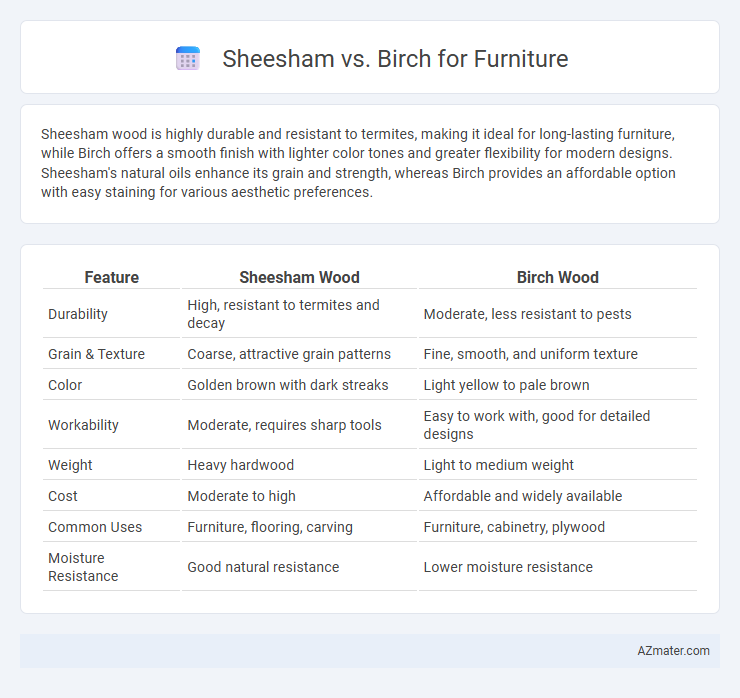Sheesham wood is highly durable and resistant to termites, making it ideal for long-lasting furniture, while Birch offers a smooth finish with lighter color tones and greater flexibility for modern designs. Sheesham's natural oils enhance its grain and strength, whereas Birch provides an affordable option with easy staining for various aesthetic preferences.
Table of Comparison
| Feature | Sheesham Wood | Birch Wood |
|---|---|---|
| Durability | High, resistant to termites and decay | Moderate, less resistant to pests |
| Grain & Texture | Coarse, attractive grain patterns | Fine, smooth, and uniform texture |
| Color | Golden brown with dark streaks | Light yellow to pale brown |
| Workability | Moderate, requires sharp tools | Easy to work with, good for detailed designs |
| Weight | Heavy hardwood | Light to medium weight |
| Cost | Moderate to high | Affordable and widely available |
| Common Uses | Furniture, flooring, carving | Furniture, cabinetry, plywood |
| Moisture Resistance | Good natural resistance | Lower moisture resistance |
Introduction to Sheesham and Birch Wood
Sheesham wood, also known as Indian rosewood, is prized for its rich grain patterns, natural durability, and resistance to termites, making it a popular choice for high-quality furniture. Birch wood, sourced primarily from Northern Hemisphere regions, is recognized for its pale color, fine grain, and smooth finish, offering a modern and clean aesthetic in furniture design. Both woods provide unique advantages, with Sheesham excelling in strength and warmth, while Birch emphasizes versatility and a lighter appearance.
Origins and Sources of Sheesham and Birch
Sheesham, also known as Indian Rosewood, originates primarily from the Indian subcontinent, notably India and Pakistan, where it grows in tropical and subtropical forests. Birch, a deciduous hardwood, is mainly sourced from the cooler climates of North America, Europe, and parts of Asia, thriving in temperate forests. The distinct geographic origins of Sheesham and Birch contribute to their unique wood grain patterns and durability characteristics, influencing their suitability for various furniture styles.
Physical Characteristics and Appearance
Sheesham wood features a rich, deep brown color with intricate grain patterns and natural oils that provide durability and resistance to moisture, making it ideal for sturdy furniture. Birch wood is lighter in color, often pale yellow to creamy white, with a fine, uniform texture and smooth finish, offering a sleek and contemporary appearance. While Sheesham offers a rustic and elegant look with its darker hues, Birch presents a clean and modern aesthetic, suitable for minimalist interior designs.
Durability and Strength Comparison
Sheesham wood exhibits higher density and natural oils, providing superior durability and resistance to termites and decay compared to Birch wood. Birch, while strong and moderately hard, tends to be more prone to dents and scratches under heavy use. The natural robustness of Sheesham makes it a preferred choice for long-lasting, sturdy furniture in high-traffic environments.
Workability and Crafting Ease
Sheesham wood offers excellent workability due to its dense grain and natural oils, making it smoother to carve and less prone to splintering, ideal for intricate furniture designs. Birch is softer and less dense, allowing faster cutting and shaping but may require more careful finishing to avoid dents and scratches. Both woods support high-quality craftsmanship, with Sheesham favored for detailed work and durability, while Birch excels in ease of handling and cost-effective production.
Price and Affordability
Sheesham wood generally commands a higher price than birch due to its durability, rich grain patterns, and natural resistance to pests, making it a premium choice for furniture. Birch is more affordable and widely available, offering a smooth, light finish that suits budget-conscious buyers without sacrificing moderate strength. For cost-effective furniture solutions, birch provides excellent value, while sheesham appeals to those prioritizing longevity and aesthetic appeal despite the higher investment.
Maintenance and Longevity
Sheesham wood offers superior durability and natural resistance to pests, requiring minimal maintenance such as occasional polishing to preserve its rich grain and finish. Birch wood, while less dense, demands regular sealing and protection from moisture to prevent warping and prolong its lifespan. Choosing Sheesham results in longer-lasting furniture with easier upkeep compared to the more maintenance-intensive Birch.
Environmental Impact and Sustainability
Sheesham wood, sourced primarily from the Indian Rosewood tree, is known for its durability and natural resistance to pests, making it a sustainable choice when harvested responsibly from certified plantations. Birch wood, often sourced from fast-growing trees native to northern regions, offers a renewable option due to its rapid regrowth and lower environmental footprint during processing. Choosing Sheesham or Birch furniture hinges on verifying sustainable forestry certifications like FSC to ensure reduced deforestation and support for eco-friendly manufacturing practices.
Best Uses in Furniture Design
Sheesham wood, known for its rich grain and durability, is ideal for heavy-use furniture like dining tables, cabinets, and bed frames due to its resistance to decay and natural oils that enhance longevity. Birch, characterized by its fine grain and smooth finish, excels in modern furniture design such as veneers, lightweight chairs, and cabinetry where a clean, bright appearance and ease of shaping are prioritized. Both woods offer unique benefits: Sheesham provides robustness and a rustic appeal, while Birch supports sleek, contemporary aesthetics with excellent paint and stain absorption.
Conclusion: Choosing Between Sheesham and Birch
Sheesham wood offers rich grain patterns, natural durability, and resistance to termites, making it ideal for long-lasting, ornate furniture. Birch provides a smooth texture, lighter color, and excellent shock resistance, suited for modern, cost-effective pieces with a clean finish. Selecting between Sheesham and Birch depends on desired aesthetics, durability requirements, and budget considerations, with Sheesham preferred for heritage-style furniture and Birch favored for contemporary, affordable designs.

Infographic: Sheesham vs Birch for Furniture
 azmater.com
azmater.com